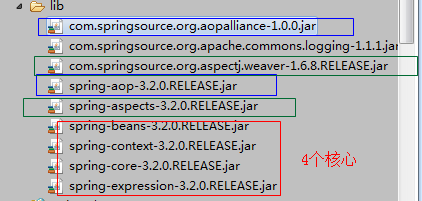一、前言
使用注解代替之前在spring配置文件中配置目标类、切面类和aop配置。
二、注意
- 需要注意的是,需要在spring配置文件中引入如下,如果不添加,切面类中的@Aspect注解将不起作用
<aop:aspectj-autoproxy/>
-
使用的时候通知单独使用
- 导入的jar包

- 当有多个切面,需要考虑其优先级时切面类使用@Order(数字:越小优先级越高) 参考:https://www.cnblogs.com/dreamfree/p/4102619.html
三、注解的使用
切面类:
@Aspect 声明切面,修饰切面类,从而获得 通知。
通知:
@Before 前置
@AfterReturning 后置
@Around 环绕
@AfterThrowing 抛出异常
@After 最终
切入点:
@PointCut ,修饰方法 private void xxx(){} 之后通过“方法名”获得切入点引用
四、代码实现
beans.xml
<!-- 扫描注解 --> <context:component-scan base-package="com.xx"/> <!-- aspectj自动代理 --> <aop:aspectj-autoproxy/>
切面类:通知单独使用
1 2 3 4 5 6 7 8 9 10 11 12 13 14 15 16 17 18 19 20 21 22 23 24 25 26 27 28 29 30 31 32 33 34 35 36 37 38 39 40 41 42 43 44 45 46 47 48 49 50 51 52 53 54 55 56 57 58 59 60 61 62 63 64 65 66 67 68 69 70 71 72 | package com.xx.myaspect;import java.util.Arrays;import org.aspectj.lang.JoinPoint;import org.aspectj.lang.ProceedingJoinPoint;import org.aspectj.lang.annotation.After;import org.aspectj.lang.annotation.AfterThrowing;import org.aspectj.lang.annotation.Around;import org.aspectj.lang.annotation.Aspect;import org.aspectj.lang.annotation.Before;import org.aspectj.lang.annotation.Pointcut;import org.springframework.core.annotation.Order;import org.springframework.stereotype.Component;/** * 切面类 * @author phoebe * @Component:类级注解 * @Aspect:切面注解 */@Component@Aspect@Order(1)public class MyAscpect { /* * 切点,方法名即是切点的id * 后面的切点直接引用方法名称即可 * 方法体不需要再配置其他 */ @Pointcut(value="execution(* com.xx.dao.UserDaoImpl.*(..))") public void pointCut(){} /* * 前置通知 * JoinPoint:带有方法名称 */ @Before("pointCut()") public void before(JoinPoint joinPoint){ String methodName = joinPoint.getSignature().getName(); System.out.println("方法名称是:"+methodName); } /* * 环绕通知需要携带ProceedingJoinPoint类型的参数 * 环绕通知类似于动态代理的全过程:ProceedingJoinPoint类型的参数可以决定是否执行目标方法。 * 而且环绕通知必须有返回值,返回值即为目标方法的返回值 * */ @Around(value="pointCut()") public Object arround(ProceedingJoinPoint pjp){ Object obj = null; String methodName = pjp.getSignature().getName(); try { //前置通知@Before System.out.println("The method " + methodName + " begins with " + Arrays.asList(pjp.getArgs())); //执行目标方法 obj = pjp.proceed(); //后置通知@After System.out.println("The method " + methodName + " ends with " + Arrays.asList(pjp.getArgs())); } catch (Throwable e) { //异常通知@AfterThrowing System.out.println("The method " + methodName + " occurs expection : " + e); throw new RuntimeException(e); } //返回通知@AfterReturning System.out.println("The method " + methodName + " ends"); return obj; } } |
dao接口类:
1 2 3 4 5 6 7 8 9 | package com.xx.dao;public interface UserDao { public void run1(); public void run2(); public void run3(); } |
dao实现类
1 2 3 4 5 6 7 8 9 10 11 12 13 14 15 16 17 18 19 | package com.xx.dao;import org.springframework.stereotype.Repository;@Repository("userDaoImpl")public class UserDaoImpl implements UserDao{ @Override public void run1() { int x = 1/0; System.out.println("run1"); } @Override public void run2() { System.out.println("run2"); } @Override public void run3() { System.out.println("run3"); }} |
测试类:
1 2 3 4 5 6 7 8 9 10 11 12 13 14 15 | package com.xx;import org.springframework.context.ApplicationContext;import org.springframework.context.support.ClassPathXmlApplicationContext;import com.xx.dao.UserDao;public class Test { public static void main(String[] args) { String xmlPath = "classpath:beans.xml"; ApplicationContext context = new ClassPathXmlApplicationContext(xmlPath); UserDao userDao = (UserDao) context.getBean("userDaoImpl"); userDao.run1(); userDao.run2(); userDao.run3(); }} |
Best Regards



【推荐】还在用 ECharts 开发大屏?试试这款永久免费的开源 BI 工具!
【推荐】国内首个AI IDE,深度理解中文开发场景,立即下载体验Trae
【推荐】编程新体验,更懂你的AI,立即体验豆包MarsCode编程助手
【推荐】轻量又高性能的 SSH 工具 IShell:AI 加持,快人一步